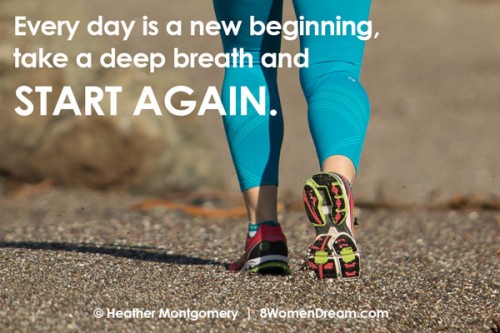We have been ingrained to ice an injury for so long. The first question I always get if anyone sees me with an injury is “Have you been icing it?”. Now there are some interesting studies on the use of ice. Mostly that we have potentially been adding to our recovery time by icing the wrong way or for the wrong reasons.
Treat an injury or your fitness goals can be sidelined
I haven’t been running. My last 10k way back in November was my last long run and I discovered something wrong after that run that is still keeping me from getting back to longer runs.
For a few weeks after the 10k I was limping, not able to push off my left foot with any normal motion. The pain started in my left calf and migrated down into the outside of my left ankle. After chatting with my triathlon coach, and with a few adjustments to my shoes I started short runs again. Everything was feeling fine, and then something weird happened.
The pain came back. This time it was a nasty knot in my right calf. My coach agreed that this was probably the real issue to begin with and recommended I take some of my own advice and actually stretch after a run. This is something I tell every client after every boot camp session and I will admit to you fellow dreamer – I suck at taking the time to do it myself.
To add insult to this particular injury I had to face the fact that my body has changed over time.
I had always been very flexible and every calf stretch I used to do was barely felt. You’ll notice I mentioned that’s when I used to do them. Twenty plus years ago.
A ton of new training to my body in the last year and my body is reminding me something I already knew.
I’m not as young as I used to be.
It took me a while to process that I couldn’t just “run through” this injury and would actually have to take care of it.
How to treat an injury
No matter how careful we are, injuries happen. My latest was a re-injury of the same calf. About a month ago I was training a boot camp session, jumped over to demonstrate and boom! My calf locked up, hard as a rock. Hopping on one foot for the rest of that session was very entertaining to watch.
In the past I would have rushed home, popped a few ibuprofen and wrapped my calf up in one of my many handy ice packs. Most of us are familiar with this injury treatment acronym: R.I.C.E.
R.I.C.E. stands for Rest, Ice, Compression, Elevation.
These are the steps that for years we thought were the best course of action for an acute injury (sharp, specific pain) to a muscle, bone or joint.
In my case, sport massage treatment discovered that the issue was not truly the calf muscle, but rather the Achilles tendon attaching that troublesome painful muscle to my heel.
A study researching the outcome of soft tissue injury and treatments, similar to my sprained muscle and tendon injury, has some very interesting outcomes specific to the use of ice.
The effects of ice have been demonstrated in numerous animal models and human studies. Ice reduces tissue temperature, blood flow, pain, and metabolism. However, and possibly more important, is the question, “Does ice application improve the treatment outcomes?” Does treatment facilitate achievement of goals related to functional limitations and sudden transient disability after injury or surgery? Bleakley et al1 reported that cold seemed to be more effective in limiting swelling and decreasing pain in the short term (immediately after application to 1 week postinjury). […] Additionally, evidence is limited that cryotherapy hastens return to participation.
So basically my initial thought to ice it down would have treated the pain, and that’s about it. I definitely wanted it to stop hurting, but long term healing wasn’t going to be helped with the R.I.C.E routine.
What’s interesting is that my body knew this. I felt the need to stretch and rotate my ankle, releasing some of the tightness and swelling.
Instead of the R.I.C.E technique, consider M.E.A.T.
There is a lot of discussion on whether one technique to treat an injury is better than the other. A few years ago, before I found fitness again, I was the queen of twisting my ankle. At least annually, I would be doing something stupid, like missing the last step on the stairs and wrench my ankle to one side or another.
A few trips to the doctor and I was getting a little annoyed that I didn’t have the excuse to go home, take it easy and just lie around with the ankle elevated. Nope. The advice I kept getting was to “use it”. Now I know that the prescription was truly M.E.A.T..
M.E.A.T. stands for Movement, Exercise, Analgesic and Treatment.
The more conservative, and effective, treatment for acute injuries to ligaments and tendons is the MEAT protocol. As mentioned earlier, MEAT stands for movement, exercise, analgesics and treatment. While immobility is detrimental to soft tissue healing, movement is beneficial because it improves blood flow to the injured area, removing debris. One of the effects of movement is the generation of heat, which increases blood flow.
This is why the application of heat is also recommended for ligament and tendon injuries. Gentle range-of-motion exercises also help improve blood flow to the injured area. Natural analgesics, or painkillers, such as proteolytic enzymes, which break down proteins, aid soft tissue healing by reducing the viscosity, or stickiness, of the extracellular fluid. […] natural analgesics decrease the painful swelling of soft-tissue injuries but do not stop the natural inflammatory reactions that lead to healing, unlike anti-inflammatories, which can actually hinder healing.
Resource: “MEAT vs. RICE Treatment”, Caring Medical and Rehabilitation Services
R.I.C.E and M.E.A.T can work together
Everything is connected in our bodies, and as many times as I wish this weren’t the case, we can’t escape it. Pain in one calf creates a shortened stride, then the other side of your body tries to compensate and the asymmetrical movement throws everything off balance. Unless we treat injuries for the goal of recovering faster.
Knowing when and how to use these techniques to treat an injury, and what their true results are, can get your fitness goals back on track faster.
Go get your fit on – Heather
Common sense reminder: If you truly are not sure what or how your injury or pain came about, please seek the advice of a doctor.

Heather Montgomery is a fitness writer, triathlete, and serial entrepreneur who is devoted to sharing what she has learned about becoming a triathlete after age 40. She uses her Metabolic Training Certification to help other women struggling to get fit in mid-life. She lives and trains in Santa Rosa, California, the new home of the Ironman triathlon. You can find her biking the Sonoma County wine trails.
Note: Articles by Heather may contain affiliate links and will be compensated if you make a purchase after clicking on an affiliate link.





